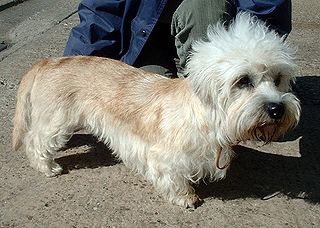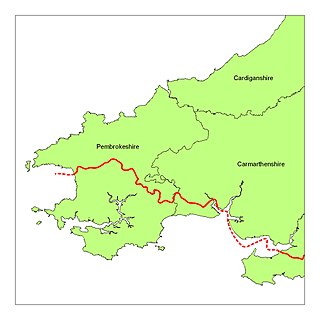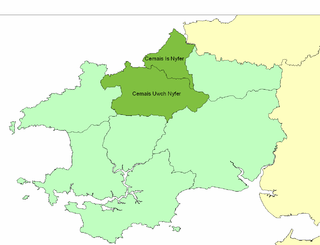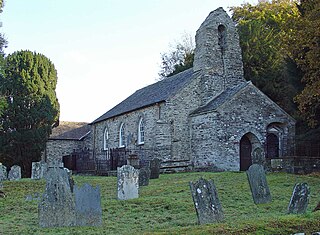
Haverfordwest is the county town of Pembrokeshire, Wales, and the most populous urban area in Pembrokeshire with a population of 12,042 in 2011, though its community boundaries made it the second-most-populous settlement in the county, with 10,812 people. The suburbs include the former parish of Prendergast, Albert Town and the residential and industrial areas of Withybush.

The Staffordshire Bull Terrier, commonly called the Staffy or Stafford, is a shorthaired, purebred dog breed of medium size that originated in the Black Country of Staffordshire in the English Midlands. It is in the terrier group, one of several group designations used by various breed registries. It has been generally agreed by authorities that the Stafford's earliest beginnings trace back centuries to mastiff types when the old bulldogs were closely linked, and used for bull and bear baiting which required large dogs in the 100–120 lb range.

The Sealyham Terrier is a rare Welsh breed of small to medium-sized terrier that originated in Wales as a working dog. It is principally a white-bodied, rough-coated breed, developed in the mid-to-late-19th century by Captain John Edwardes at Sealyham House, Pembrokeshire.

A Dandie Dinmont Terrier is a small Scottish dog breed in the terrier family. The breed has a very long body, short legs, and a distinctive topknot of hair on the head. They are friendly but tough, and are suitable for interaction with older children. There are breed-specific health concerns: they can be affected by spinal problems due to their elongated body, and the breed is affected by canine cancer at a higher than average rate.

The Kerry Blue Terrier is a breed of dog. Originally bred to control vermin including rats, rabbits, badgers, foxes, otters and hares, over time the Kerry became a general working dog used for a variety of jobs including herding cattle and sheep, and as a guard dog. Today the Kerry has spread around the world as a companion and working dog. Despite a Kerry Blue winning Crufts in 2000, it remains an "unfashionable" breed, and is distinctly uncommon; however, it is not as threatened as some of the other terrier breeds such as the Skye Terrier, Sealyham Terrier, and Dandie Dinmont Terrier.

Wolfscastle, also spelt Wolf's Castle, is a village and community in Pembrokeshire, between Haverfordwest and Fishguard, in southwest Wales. It was historically in the parish of St Dogwells.

An earthdog test or earthdog trial tests the working ability and instinct of the small, often short-legged terriers or Dachshunds. These dogs were bred to hunt vermin and other quarry which lived in underground dens. Earthdog den tests involve man-made tunnels that the dogs must navigate, while scenting a rat, "the quarry." The dog must follow the scent to the quarry and then "work" the quarry. Depending on the sanctioning organization, “working” means barking, scratching, staring, pawing, digging; any active behavior. The quarry is protected at all times by wooden bars across the end of the tunnel. The hunting encounter is controlled, and neither the dog nor the quarry are endangered by the activity.

The Landsker Line is a term used for the language border in Wales between the largely Welsh-speaking and largely English-speaking areas in Pembrokeshire and Carmarthenshire. The English-speaking areas, south of the Landsker line and known as Little England beyond Wales, are notable for having been English linguistically and culturally for many centuries despite being far from the England–Wales border.

A working terrier is a small type of dog which pursues its quarry into the earth. According to the Oxford English Dictionary, the name dates back to at least 1440, derived from French chien terrier 'digging dog', which is from Medieval Latin terrarius, ultimately from Latin terra (earth).

William Edwardes, 1st Baron Kensington of Johnston Hall, Pembrokeshire, was a British landowner and a long-standing Member of Parliament.

Cemais was an ancient cantref of the Kingdom of Dyfed, from the 11th century a Norman Marcher Lordship, from the 16th century a Hundred, and is now part of Pembrokeshire, Wales. It occupied the coastal area between the Teifi estuary and Fishguard, and the northern and southern slopes of the Preseli Hills, covering an area of approximately 140 square miles (360 km2). The Afon Nyfer divided it into two commotes: Cemais Is Nyfer to the north and Cemais Uwch Nyfer to the south.

Vulnerable Native Breeds are a group of dog breeds originating in the United Kingdom and Ireland, and identified by The Kennel Club (KC) as having annual registration numbers of 300 puppies or fewer within the UK. The need for such a list was first identified in June 2003, with research conducted by the KC to identify the extent of the vulnerability and viability of each breed. It was a joint project, with the KC working with the British and Irish Native Breeds Trust, later to be known simply as the Native Dog Breeds Trust. The breeds on the list have been promoted at events such as Discover Dogs and Crufts, and by asking that owners of these breeds mate their dogs rather than having them spayed.

Manordeifi is a parish and community in the hundred of Cilgerran, in the northeast corner of Pembrokeshire, Wales. The population of the community in 2001 was 478. It has an elected community council and is part of the Cilgerran electoral ward for the purposes of elections to Pembrokeshire County Council.
The name Rhyd-y-gors or Rhydygors has been associated with two historic sites near the market town of Carmarthen in Southwest Wales. The first was the Norman Rhyd-y-gors Castle and the other was Rhyd-y-gors Mansion, home of the Edwardes family.

The Big House, also known as Landshipping House, is a historic house on the banks of the River Cleddau in Landshipping, Pembrokeshire, Wales.

The Haining is a country house and estate in Selkirk in the Scottish Borders. The present house dates from the 1790s, and was a property of the Pringle family. In 2009, the house and grounds were bequeathed to the people of Selkirkshire and the wider public. The Haining Charitable Trust is now working on developing the building as a centre for exhibitions and events, highlighting art, culture and history. The ground floor of the House has been refurbished and is now let out for various events and functions. The Old Coach House and Stable outbuildings have been refurbished and now offer six brand new artists studios. A two-bedroom holiday apartment, The Ettrick, is also now available within the grounds available for booking via Visit Scotland. The "Old Ginger" statue is located in the kennel yard.

Blaenffos is a small village of around 200 inhabitants in the north of Pembrokeshire, Wales, in the community of Boncath. It sits on the boundary between the former parishes of Llanfihangel Penbedw and Castellan Chapelry.
Treffgarne Hall is a privately owned Grade II listed Georgian country house, located to the west of the village of Treffgarne, West Wales. It was built in 1842 for David Evans whose family had owned the land for some time.

Ffynone is a mansion and estate near Boncath, Pembrokeshire, Wales, in the parish of Manordeifi. The original Georgian design was by architect John Nash and later remodelled by Inigo Thomas.

Orielton is a historic country house near Hundleton in Pembrokeshire, Wales. It has been used as a field studies centre for environmental sciences.




















